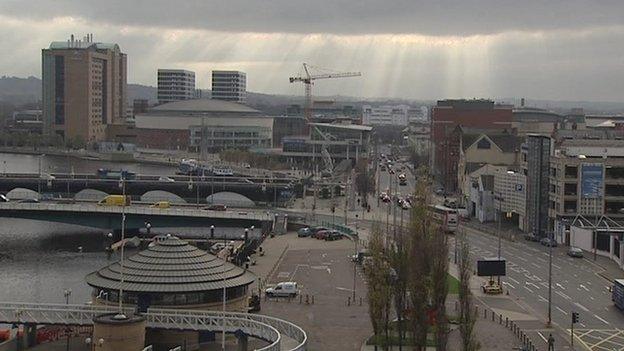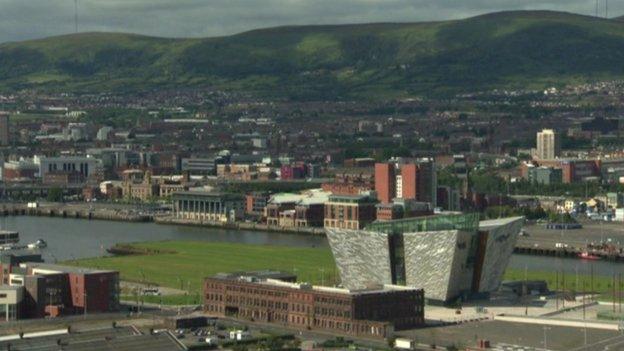Belfast city centre 'key to unlocking economic potential'
- Published

Joe Berridge, thinks that traffic calming on Oxford Street, the road that runs past the Waterfront Hall, would allow the city centre to "flow" more easily up to the riverside.
"Belfast city centre is the most important place in Northern Ireland."
That is the provocative statement in new research looking at regeneration options for the city.
"It's not intended as an antagonistic statement," says the report author, Joe Berridge, a partner at the Toronto-based consultants Urban Strategies.
Rather, he points to the experience of other places that show that city centres are the key for the creation of a whole region's economic wealth.
In simple terms, an attractive, well functioning city centre sends the message to investors that they are in a competent and confident place.
Opportunities
Some of the issues with Belfast that he identifies are well rehearsed: A lack of top class office space and a city centre that still does not feel like a particularly user-friendly place to live.
There is also a retail sector that is still digesting the impact of a recession and the big structural shift towards online shopping.
But Mr Berridge sees some big opportunities.
"Hallelujah," he says when asked about the University of Ulster's decision to move into the city centre.
His report says the move should be "transformational" for both the physical environment of the northern edge of the city centre and for the surrounding communities.
The other big project that he welcomes is Translink's commitment to building its new transport hub at Great Victoria Street.
Green space
In itself, that should be a positive development for the transport system but he thinks it also gives an opportunity to develop new office space, which might need to be done with public money.
Some of his other proposals are modest but he sees them as important for making the city more liveable.
For example, adding more green space to the city centre.
Currently there is really only one green space in the city centre, the city hall lawn.
Could the hard, windswept Writers Square in front of St Anne's Cathedral be grassed-over?
He also thinks that traffic calming on Oxford Street, the road that runs past the Waterfront Hall, would allow the city centre to 'flow' more easily up to the riverside.
There is also a plan for a new footbridge to Titanic Quarter, which is currently poorly connected to the city centre.
He also sees the need for the 'next big thing' in tourism to give visitors a reason to stay longer in the city - that might take the form of a new museum or gallery.

A planned new footbridge to Titanic Quarter will help improve its connection to the city centre.
The BBC's future intentions are also a factor in his thinking for the city centre.
The broadcaster has said it will leave its current premises at Broadcasting House.
There have been persistent rumours of a move to Titanic Quarter, but it has taken no decision about a preferred option for its new base.
Mr Berridge favours a city centre location saying it would have "a powerful regeneration benefit", particularly if it can be located near the University of Ulster.
One option he identifies is at Royal Exchange, the long-delayed retail scheme that has so far been unable to attract an anchor tenant.
There have been plenty of plans for Belfast in the past - what might make this one more deliverable is that the council will take control of planning powers when the new "super council" begins work in 2015.